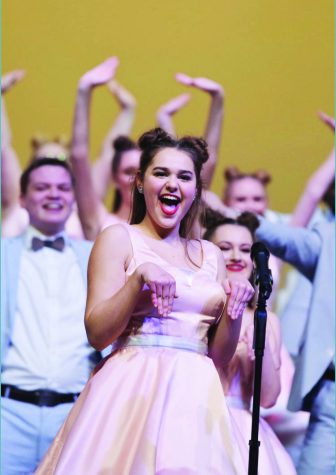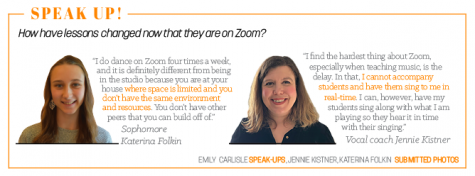As COVID-19 made its way across the country, students found themselves saying goodbye as schools closed doors to keep in line with social distancing procedures to flatten the curve. As students adapted to distance learning since mid-March, teachers weren’t far behind, but according to band teacher Michael Pote, the transition wasn’t easy. “We in the band area especially had not done this at all, so our learning curve when all this happened was pretty steep,” Pote said.

According to Pote, band teachers had to shift lessons away from the group focus that most of the course contains. Pote said, for him, this shift took about a week before he felt that he was doing well and that these changes online won’t disappear once quarantine ends.
“What we’re being very aware of is, as much as teachers have to adjust, (for) high school students the adjustment is even greater,” Pote said. “They’re dealing with a lot of things. With all of their classes, we’ve tried to be very aware of that and not over assign things to them, not overwhelm them.”
One student making the adjustment is junior and choir student Madeline Blank. Since the start of social distancing, Blank’s private voice lessons have moved to Zoom, which limits free conferences between three or more people to be no longer than 40 minutes.
“My lessons are 30 minutes, and they happen maybe once or twice a week now.” Blank said “Before this I had it once a week for an hour. I’ve noticed also that it’s harder now that my time is kind of cut and it takes more time to work out the technical things.”
Blank said time is not the only issue. Other technical problems have included synchronization of sound and correcting posture in calls, but while these issues exist, the lessons are still useful to the students.
“Obviously, desperate times call for desperate measures, and obviously I know that I shouldn’t be going to my teacher’s studio. It’s not awful and it’s been working out well just besides the lag and the adjustments,” Blank said.
Sophomore Tenly DeVoe is a ballet student who has a similar experience when using Zoom. While problems do arise, such as using pointe shoes on floors not designed for them, DeVoe spoke of a greater reason for the Zoom classes.
“The Zoom classes keep us in shape to help us be properly prepared for when we go back after such a long time away,” DeVoe said via email.
While maintaining her skills was important to Blank as well, she said there were other reasons she continued practice. Along with having the ability to talk to someone outside of her family, Blank said, “It gives me a sense of routine and normality, like everything in the world is super weird but at least I know that when I have my voice lessons that would be as normal as it can be.”

While teachers may change their lessons to accommodate the distance learning environment, some traits will remain. Pote said, “(During) the first week we joked with our students because we, the band teachers, weren’t heavy Canvas users because again everything is done in class.” As the teachers have been progressing through quarantine they’ve also learned more about Canvas and have been using the options the platform provides.
DeVoe said she liked Zoom classes for the option to do classes at home and that they weren’t too different from studio classes. While Pote said distance learning provided an opportunity for students to learn, he also said he’d rather return to normal classes.
“I think every teacher would rather have the classroom and one on one instruction,” he said.
While Blank said she has a positive outlook on the classes, she too still prefers to return to physical instruction.
“Instruments and singing are pretty loud, everyone’s trapped in the house together and anyone would feel guilty making a lot of noise (because) everyone would have to deal with it,” she said. “I think about how before all this happened, I was so exhausted like every other choir kid. Now I think about how much I would give to be that tired again so I could use my voice.”

















































































![Review: “The Immortal Soul Salvage Yard:” A criminally underrated poetry collection [MUSE]](https://hilite.org/wp-content/uploads/2025/03/71cju6TvqmL._AC_UF10001000_QL80_.jpg)
![Review: "Dog Man" is Unapologetically Chaotic [MUSE]](https://hilite.org/wp-content/uploads/2025/03/dogman-1200x700.jpg)
![Review: "Ne Zha 2": The WeChat family reunion I didn’t know I needed [MUSE]](https://hilite.org/wp-content/uploads/2025/03/unnamed-4.png)
![Review in Print: Maripaz Villar brings a delightfully unique style to the world of WEBTOON [MUSE]](https://hilite.org/wp-content/uploads/2023/12/maripazcover-1200x960.jpg)
![Review: “The Sword of Kaigen” is a masterpiece [MUSE]](https://hilite.org/wp-content/uploads/2023/11/Screenshot-2023-11-26-201051.png)
![Review: Gateron Oil Kings, great linear switches, okay price [MUSE]](https://hilite.org/wp-content/uploads/2023/11/Screenshot-2023-11-26-200553.png)
![Review: “A Haunting in Venice” is a significant improvement from other Agatha Christie adaptations [MUSE]](https://hilite.org/wp-content/uploads/2023/11/e7ee2938a6d422669771bce6d8088521.jpg)
![Review: A Thanksgiving story from elementary school, still just as interesting [MUSE]](https://hilite.org/wp-content/uploads/2023/11/Screenshot-2023-11-26-195514-987x1200.png)
![Review: "When I Fly Towards You", cute, uplifting youth drama [MUSE]](https://hilite.org/wp-content/uploads/2023/09/When-I-Fly-Towards-You-Chinese-drama.png)
![Postcards from Muse: Hawaii Travel Diary [MUSE]](https://hilite.org/wp-content/uploads/2023/09/My-project-1-1200x1200.jpg)
![Review: "Ladybug & Cat Noir: The Movie," departure from original show [MUSE]](https://hilite.org/wp-content/uploads/2023/09/Ladybug__Cat_Noir_-_The_Movie_poster.jpg)
![Review in Print: "Hidden Love" is the cute, uplifting drama everyone needs [MUSE]](https://hilite.org/wp-content/uploads/2023/09/hiddenlovecover-e1693597208225-1030x1200.png)
![Review in Print: "Heartstopper" is the heartwarming queer romance we all need [MUSE]](https://hilite.org/wp-content/uploads/2023/08/museheartstoppercover-1200x654.png)



